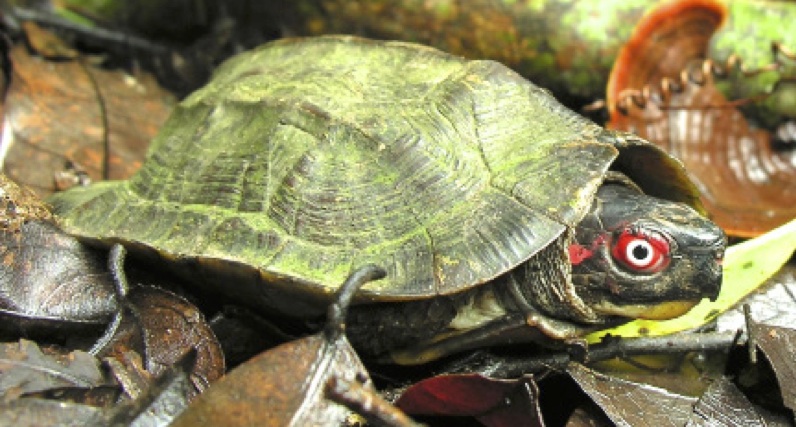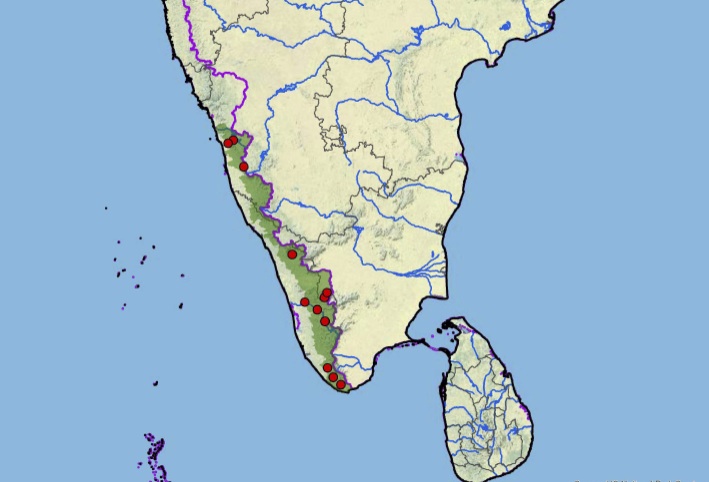Vijayachelys silvatica, 078
Vijayachelys silvatica (Henderson 1912) –
Cochin Forest Cane Turtle
V. Deepak1,3, Peter Praschag2, and Karthikeyan Vasudevan1,4
1Wildlife Institute of India, P.O. Box 18, Dehradun 248001 India;
2Am Katzelbach 98, 8054 Graz, Austria [[email protected]];
3Present Address: Centre for Ecological Sciences, Indian Institute of Science,
Bangalore 560012, India [[email protected]];
4Present Address: Centre for Cellular and Molecular Biology, Laboratory for the Conservation of Endangered Species,
Pillar 162, PVNR Expressway, Hyderguda, Attapur Ring Road, Hyderabad 500048, India [[email protected]]
Summary. – The Cochin Forest Cane Turtle, Vijayachelys silvatica (Family Geoemydidae), is a cryptic species in a monotypic genus endemic to the semi-evergreen and evergreen forests of the Western Ghats in southwestern India. It is the smallest turtle species in India, with carapace length (CL) in females up to 139 mm and males up to 126 mm. The species occurs at densities at 0.8 individuals per hectare and the home range varies from 3.5 to 12 ha. Vijayachelys silvatica is omnivorous, with the diet including insects, molluscs, earthworms, millipedes, and fruits. Most mating behavior occurs during the rainy season between June and November. One to two clutches are produced; the clutch size ranges from 1 to 4 eggs, and hatchlings measure 37–40 mm in CL. The major threats to this species are habitat loss and subsistence hunting. Conservation measures should focus on identification of crucial turtle habitats and creating awareness among wildlife protection staff and local people about the conservation status of the species.
Distribution. – India. Endemic to the Western Ghats of southwestern coastal India, in the states of Kerala, Karnataka, and Tamil Nadu.
Synonymy. – Geoemyda silvatica Henderson 1912, Heosemys silvatica, Vijayachelys silvatica.
Subspecies. – None recognized.
Status. – IUCN 2014 Red List: Endangered (EN B1+2c, assessed 2000); TFTSG Draft Red List: Endangered (EN, assessed 2011); CITES: Appendix II; India: Indian Wildlife (Protection) Act (1972): Schedule I.
Citation:
Deepak, V., Praschag, P., and Vasudevan, K. 2014. Vijayachelys silvatica (Henderson 1912) – Cochin Forest Cane Turtle. In: Rhodin, A.G.J., Pritchard, P.C.H., van Dijk, P.P., Saumure, R.A., Buhlmann, K.A., Iverson, J.B., and Mittermeier, R.A. (Eds.). Conservation Biology of Freshwater Turtles and Tortoises: A Compilation Project of the IUCN/SSC Tortoise and Freshwater Turtle Specialist Group. Chelonian Research Monographs No. 5, pp. 078.1–7, doi:10.3854/crm.5.078.silvatica.v1.2014, //iucn-tftsg.org/cbftt/.
(Adobe Acrobat 6.0 or later required)

Adult male Vijayachelys silvatica from the rainforests of Anamalais.
Photo by V. Deepak.
Distribution:

Distribution of Vijayachelys silvatica in the Western Ghats of southwestern peninsular India, south Asia. Purple lines = boundaries delimiting major watersheds (level 3 hydrologic unit compartments – HUCs); red dots = museum and literature occurrence records of native populations based on Iverson (1992) plus more recent and authors’ data; green shading = projected native distribution based on GIS-defined HUCs constructed around verified localities and then adding HUCs that connect known point localities in the same watershed or physiographic region, and similar habitats and elevations as verified HUCs (Buhlmann et al. 2009; TTWG 2014), and adjusted based on authors’ subsequent data.








